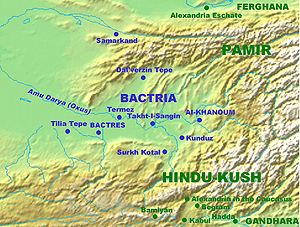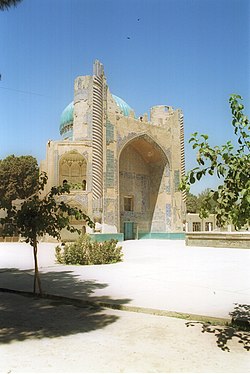| Revision as of 20:52, 2 February 2007 editCabolitae (talk | contribs)Extended confirmed users, Pending changes reviewers3,973 edits moved a link to External Links section← Previous edit | Revision as of 21:00, 2 February 2007 edit undoCabolitae (talk | contribs)Extended confirmed users, Pending changes reviewers3,973 edits →History of Balkh: Aryan tribes addedNext edit → | ||
| Line 8: | Line 8: | ||
| ==History of Balkh== | ==History of Balkh== | ||
| ].]] | ].]] | ||
| Balkh is considered to be the first city to which the ]-speaking ] tribes moved from the North of ], approximately between 2500 - 2000 ]. | |||
| The changing climate has led to ] since antiquity, when the region was very fertile. The antiquity and greatness of the place are recognized by the native populations, who speak of it as the ''Mother of Cities'' and the birth place of ] at Balkh and also believed by ] that he is buried there. Its foundation is mythically ascribed to ], the ] ]; and it is at least certain that, at a very early date, it was the rival of ], ] and ]. There is a long-standing tradition that an ancient shrine of ] was to be found here, a temple so rich it invited plunder. | The changing climate has led to ] since antiquity, when the region was very fertile. The antiquity and greatness of the place are recognized by the native populations, who speak of it as the ''Mother of Cities'' and the birth place of ] at Balkh and also believed by ] that he is buried there. Its foundation is mythically ascribed to ], the ] ]; and it is at least certain that, at a very early date, it was the rival of ], ] and ]. There is a long-standing tradition that an ancient shrine of ] was to be found here, a temple so rich it invited plunder. | ||
Revision as of 21:00, 2 February 2007
36°45′N 66°54′E / 36.750°N 66.900°E / 36.750; 66.900 Balkh (Persian: بلخ) is a small town in the Province of Balkh, Afghanistan, about 20 kilometers northwest of the provincial capital, Mazari Sharif, and some 74 km (46 miles) south of the Amu Darya, the Oxus River of antiquity, of which a tributary formerly flowed past Balkh.
Balkh was one of the major cities of Khorasan. It was located in a Persian-speaking area of eastern Persia.
The ancient city of Balkh, the oldest in today's Afghanistan, is associated with the Vedic name Bhakri, which later became Bactra for the Greeks, giving its name to Bactria. It was mostly known as the centre and capital of Bactria or Takharistan. Balkh is now for the most part a mass of ruins, situated some 12 km from the right bank of the seasonally-flowing Balkh River, at an elevation of about 365 m (1,200 ft).
History of Balkh

Balkh is considered to be the first city to which the Indo-European-speaking Aryan tribes moved from the North of Amy Darya, approximately between 2500 - 2000 BC.
The changing climate has led to desertification since antiquity, when the region was very fertile. The antiquity and greatness of the place are recognized by the native populations, who speak of it as the Mother of Cities and the birth place of Zoroaster at Balkh and also believed by Zoroastrians that he is buried there. Its foundation is mythically ascribed to Kaiomurs, the Persian Romulus; and it is at least certain that, at a very early date, it was the rival of Ecbatana, Nineveh and Babylon. There is a long-standing tradition that an ancient shrine of Anahita was to be found here, a temple so rich it invited plunder.
For a long time the city and country was the central seat of the Zoroastrian religion, the founder of which, Zoroaster, died within the walls, according to the Persian poet Firdousi. Armenian sources state that the Parthian Arsac established his capital here.
Before the Common Era, Balkh had its own Kingdoms and Empires i.e. Kavi Daynasty, Paradata (Peshdādyān in Persian), Aspa Kindom, etc. In Shahnāmah, the name of the Paradata Kings who ruled in Balkh have been mentioned: Keyumars, Hushang, Tahmuras, Jamshid, Zahhak, Kawa or Kaveh, Fereydun and his grandson Manuchehr.
From the Memoirs of Xuanzang, we learn that, at the time of his visit in the 7th century, there were in the city, or its vicinity, about a hundred Buddhist convents, with 3,000 devotees, and that there was a large number of stupas, and other religious monuments. The most remarkable was the Nava Vihara, which possessed a very costly statue of Buddha. The temple was led by Kashmiri Brahmins called Pramukh (who, through the arabized form of the name, Barmak, came to be known as the Barmakids). Shortly before the Arabic conquest, the monastery became a Zoroastrian fire-temple. A curious notice of this building is found in the writings of Arabian geographer Ibn Hawqal, an Arabian traveler of the 10th century, who describes Balkh as built of clay, with ramparts and six gates, and extending half a parasang. He also mentions a castle and a mosque.
At the time of the Islamic conquest of Persia in the 7th century, however, Balkh had provided an outpost of resistance and a safe haven for the Persian emperor Yedzgird who fled there from the armies of Umar.
Idrisi, in the 12th century, speaks of its possessing a variety of educational establishments, and carrying on an active trade. There were several important commercial routes from the city, stretching as far east as India and China.
In 1220 Jenghiz Khan sacked Balkh, butchered its inhabitants and levelled all the buildings capable of defense — treatment to which it was again subjected in the 14th century by Timur. Notwithstanding this, however, Marco Polo could still describe it as "a noble city and a great."
In the 16th century the Uzbeks entered Balkh. The Moghul Shah Jahan fruitlessly fought them there for several years in the 1640s. Balkh formed the government seat of Aurangzeb in his youth. In 1736 it was conquered by Nadir Shah. Under the Durani monarchy it fell into the hands of the Afghans; it was conquered by Shah Murad of Kunduz in 1820, and for some time was subject to the Emirate of Bukhara. In 1850 Mahommed Akram Khan, Barakzai, captured Balkh, and from that time it remained under Afghan rule.
Ancient ruins of Balkh

No professional archaeologist had ever been able to work at Balkh until 2003 when excavations started to identify early strata down to the period of the Achaemenids and the Greeks. Remains of Hellenistic capitals were found, identified as remnants of the Seleucid and Greco-Bactrian city of Bactra.
The earlier Buddhist constructions have proved more durable than the Islamic period buildings. The Top-Rustam is 50 yd (46 m) in diameter at the base and 30 yd (27 m) at the top, circular and about 50 ft (15 m) high. Four circular vaults are sunk in the interior and four passages have been pierced below from the outside, which probably lead to them. The base of the building is constructed of sun-dried bricks about 2 ft (600 mm) square and 4 or 5 in (100 to 130 mm) thick. The Takht-e Rustam is wedge-shaped in plan with uneven sides. It is apparently built of pisé mud (i.e. mud mixed with straw and puddled). It is possible that in these ruins we may recognize the Nan Vihara described by the Chinese traveller Xuanzang. There are the remains of many other topes (or stupas) in the neighborhood.
The mounds of ruins on the road to Mazari Sharif probably represent the site of a city yet older than those on which stands the modern Balkh.
Balkh in 1911

Because of a malaria outbreak during flood season at Balkh, the regional capital was shifted in the 1870s to Mazari Sharif.
In 1911, the Encyclopedia Britannica described a settlement of about 500 Afghan settlers, a colony of Jews and a small bazaar set in the midst of a waste of ruins and acres of debris. Entering by the west (Akcha) gate, one passed under three arches, in which the compilers recognized the remnants of the former Friday Mosque (Jama Masjid). The outer walls, mostly in utter disrepair, were estimated about 6½-7 miles (10.5 to 11.3 km) in perimeter. In the south-east, they were set high on a mound or rampart, which indicated a Mongol origin to the compilers.
The fort and citadel to the north-east are built well above the town on a barren mound and are walled and moated. There was, however, little left but the remains of a few pillars. The Green Mosque Masjid Sabz, named for its green-tiled dome (illustration, right), is said to be the tomb of the khwaja Abul Narsi Parsar. Nothing but the arched entrance remained of the former madrasa.
The town was garrisoned in 1911 by a few hundred irregulars (kasidars), the regular troops of Afghan Turkestan being cantoned at Takhtapul, near Mazari Sharif. The gardens to the north-east contained a caravanserai that formed one side of a courtyard, which was shaded by a group of magnificent chenar trees Platanus orientalis.
Balkh today
A project of modernization was undertaken in 1934, in which eight streets were laid out, housing and bazaars built. Modern Balkh is a center of the cotton industry, of the skins known commonly as "Persian" lamb, and for agricultural produce like almonds and melons. Numerous places of interest are to be seen today aside from the ancient ruins and fortifications:
- The madrasa of Sayed Subhan Quli Khan.
- Bala-Hesar, the shrine and mosque of Khwaja Nasr Parsa.
- The tomb of the poetess Rabia Balkhi.
- The Nine Domes Mosque (Masjid Now Gumbad). This exquisitely ornamented mosque, also referred to as Haji Piyada, is the earliest Islamic monument yet identified in Afghanistan.
See also
- The Barmakids, who were from that city.
- The Bahlikas
External links
- Encyclopaedia Britannica, 1911
- (Balkh) Mazar-i-Sharif
- Daud Saba's brief description, 1998
- Tajik poets and others, many connected with Balkh.
- Report on scavenging treasurer seekers at Balkh, January 20, 2002
- Balkh Trading Co. Ltd